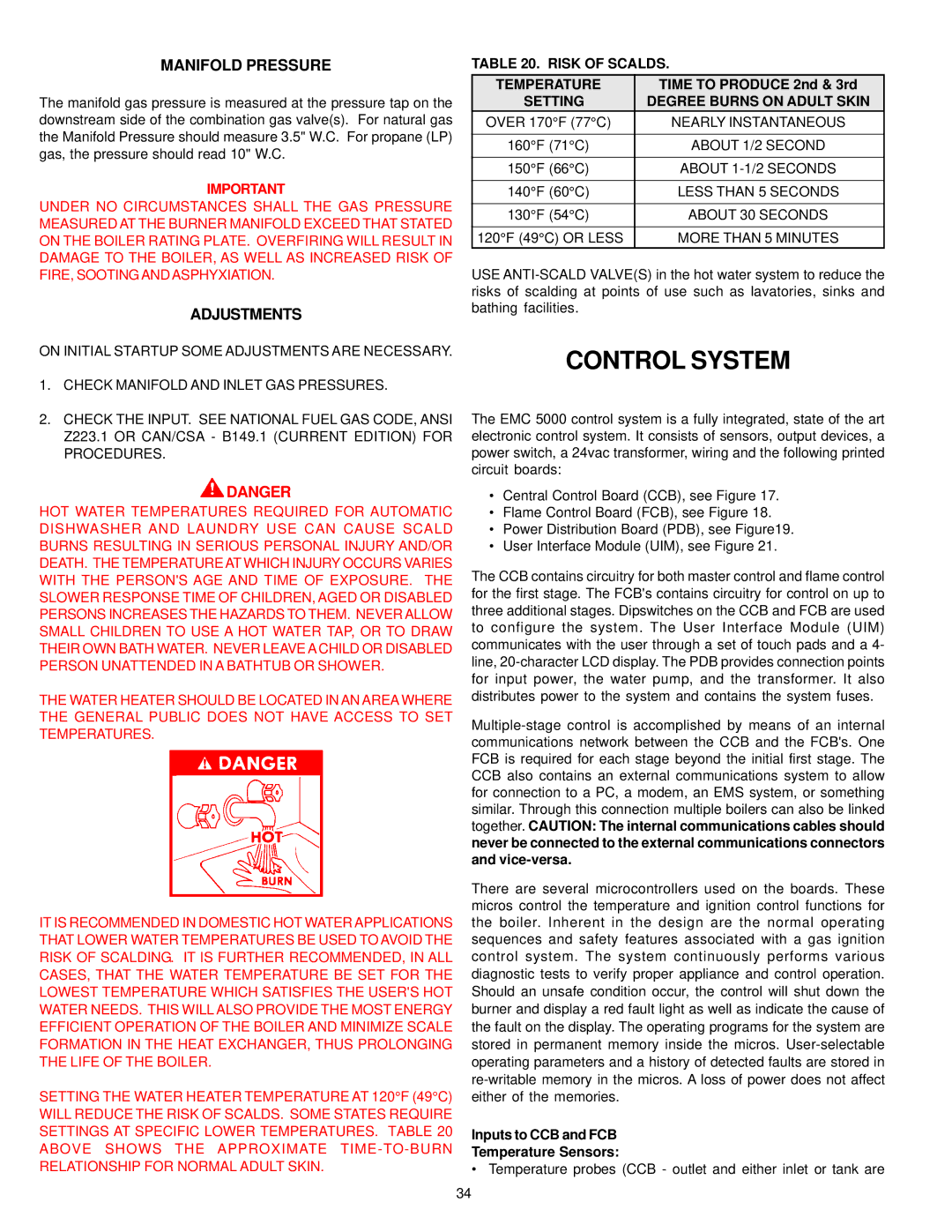
MANIFOLD PRESSURE
The manifold gas pressure is measured at the pressure tap on the downstream side of the combination gas valve(s). For natural gas the Manifold Pressure should measure 3.5" W.C. For propane (LP) gas, the pressure should read 10" W.C.
IMPORTANT
UNDER NO CIRCUMSTANCES SHALL THE GAS PRESSURE MEASURED AT THE BURNER MANIFOLD EXCEED THAT STATED ON THE BOILER RATING PLATE. OVERFIRING WILL RESULT IN DAMAGE TO THE BOILER, AS WELL AS INCREASED RISK OF FIRE, SOOTING AND ASPHYXIATION.
ADJUSTMENTS
ON INITIAL STARTUP SOME ADJUSTMENTS ARE NECESSARY.
1. CHECK MANIFOLD AND INLET GAS PRESSURES.
TABLE 20. RISK OF SCALDS.
TEMPERATURE | TIME TO PRODUCE 2nd & 3rd |
SETTING | DEGREE BURNS ON ADULT SKIN |
OVER 170°F (77°C) | NEARLY INSTANTANEOUS |
|
|
160°F (71°C) | ABOUT 1/2 SECOND |
|
|
150°F (66°C) | ABOUT |
|
|
140°F (60°C) | LESS THAN 5 SECONDS |
|
|
130°F (54°C) | ABOUT 30 SECONDS |
|
|
120°F (49°C) OR LESS | MORE THAN 5 MINUTES |
USE
CONTROL SYSTEM
2.CHECK THE INPUT. SEE NATIONAL FUEL GAS CODE, ANSI Z223.1 OR CAN/CSA - B149.1 (CURRENT EDITION) FOR PROCEDURES.
![]() DANGER
DANGER
HOT WATER TEMPERATURES REQUIRED FOR AUTOMATIC DISHWASHER AND LAUNDRY USE CAN CAUSE SCALD BURNS RESULTING IN SERIOUS PERSONAL INJURY AND/OR DEATH. THE TEMPERATURE AT WHICH INJURY OCCURS VARIES WITH THE PERSON'S AGE AND TIME OF EXPOSURE. THE SLOWER RESPONSE TIME OF CHILDREN, AGED OR DISABLED PERSONS INCREASES THE HAZARDS TO THEM. NEVER ALLOW SMALL CHILDREN TO USE A HOT WATER TAP, OR TO DRAW THEIR OWN BATH WATER. NEVER LEAVE A CHILD OR DISABLED PERSON UNATTENDED IN A BATHTUB OR SHOWER.
THE WATER HEATER SHOULD BE LOCATED IN AN AREA WHERE THE GENERAL PUBLIC DOES NOT HAVE ACCESS TO SET TEMPERATURES.
IT IS RECOMMENDED IN DOMESTIC HOT WATER APPLICATIONS THAT LOWER WATER TEMPERATURES BE USED TO AVOID THE RISK OF SCALDING. IT IS FURTHER RECOMMENDED, IN ALL CASES, THAT THE WATER TEMPERATURE BE SET FOR THE LOWEST TEMPERATURE WHICH SATISFIES THE USER'S HOT WATER NEEDS. THIS WILL ALSO PROVIDE THE MOST ENERGY EFFICIENT OPERATION OF THE BOILER AND MINIMIZE SCALE FORMATION IN THE HEAT EXCHANGER, THUS PROLONGING THE LIFE OF THE BOILER.
SETTING THE WATER HEATER TEMPERATURE AT 120°F (49°C)
WILL REDUCE THE RISK OF SCALDS. SOME STATES REQUIRE SETTINGS AT SPECIFIC LOWER TEMPERATURES. TABLE 20 ABOVE SHOWS THE APPROXIMATE
The EMC 5000 control system is a fully integrated, state of the art electronic control system. It consists of sensors, output devices, a power switch, a 24vac transformer, wiring and the following printed circuit boards:
•Central Control Board (CCB), see Figure 17.
•Flame Control Board (FCB), see Figure 18.
•Power Distribution Board (PDB), see Figure19.
•User Interface Module (UIM), see Figure 21.
The CCB contains circuitry for both master control and flame control for the first stage. The FCB's contains circuitry for control on up to three additional stages. Dipswitches on the CCB and FCB are used to configure the system. The User Interface Module (UIM) communicates with the user through a set of touch pads and a 4- line,
There are several microcontrollers used on the boards. These micros control the temperature and ignition control functions for the boiler. Inherent in the design are the normal operating sequences and safety features associated with a gas ignition control system. The system continuously performs various diagnostic tests to verify proper appliance and control operation. Should an unsafe condition occur, the control will shut down the burner and display a red fault light as well as indicate the cause of the fault on the display. The operating programs for the system are stored in permanent memory inside the micros.
Inputs to CCB and FCB
Temperature Sensors:
• Temperature probes (CCB - outlet and either inlet or tank are
34
